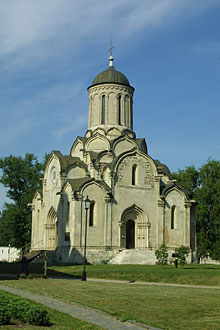 |
 This medieval monastery, located on the banks of the Yauza River, contains the oldest surviving church in Moscow, and is perhaps most famous as the home and final resting place of the great 15th Century icon painter, Andrei Rublev, who is commemorated in the Museum of Ancient Russian Art.
This medieval monastery, located on the banks of the Yauza River, contains the oldest surviving church in Moscow, and is perhaps most famous as the home and final resting place of the great 15th Century icon painter, Andrei Rublev, who is commemorated in the Museum of Ancient Russian Art.
The Andronikov Monastery was founded in 1357 by Metrapolitan Alexei, and takes its name from its first hegumen (Orthodox abbot), St. Andronik. The Savior Cathedral, which was completed in 1427, became Moscow's oldest stone structure after the destruction of the Savior Cathedral in the Wood in the 1930's. It is a simple but attractive structure of pale brick, with layers of kokoshniki leading up to a green helmet-shaped dome. The interior was originally decorated with frecoes by Andrei Rublev and Daniil Cherniy, but only fragments have survived.
Opposite the Savior Cathedral stands the Refectory, a two-storey, tent-roofed structure built under Ivan the Terrible between 1504 and 1506. Joined to it is the Church of the Archangel Michael, which was begun in 1694 as a private chapel for the Lopukhin family. It took nearly forty years to complete after Yevdokiya Lopukhina, first wife of Peter the Great, fell from favor with the Tsar and was banished to a convent. To prevent them causing trouble, Peter had her family exiled to Siberia. This ensemble of buildings was once crowned by a magnificent neoclassical bell tower that, tragically, was destroyed by the Bolsheviks in 1929.
The monastery was, from its inception, a centre of book copying in Moscow. An impressive archive of manuscripts was kept there, but most were destroyed, either by fire in 1748 or by Napoleon's troops in 1812. Later in the 19th Century, a theological seminary was established there. After the Revolution, the monastery was swiftly closed, and became for a while one of the first penal colonies of the Vecheka (the forerunner of the KGB). Later it was allocated as housing for workers in a nearby factory. It was only saved from total destruction after World War Two, and was declared a national monument in 1947.
In 1960, the Museum of Ancient Art and Culture was established in the monastery. The main collection of icons is housed in the former residence of the hegumen, but there are various other displays in the monastery's various building. Now once again occupied by monks, the monastery is well worth visiting for an insight into medieval Orthodox culture.
|
 |

 This medieval monastery, located on the banks of the Yauza River, contains the oldest surviving church in Moscow, and is perhaps most famous as the home and final resting place of the great 15th Century icon painter, Andrei Rublev, who is commemorated in the Museum of Ancient Russian Art.
This medieval monastery, located on the banks of the Yauza River, contains the oldest surviving church in Moscow, and is perhaps most famous as the home and final resting place of the great 15th Century icon painter, Andrei Rublev, who is commemorated in the Museum of Ancient Russian Art.